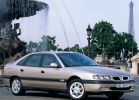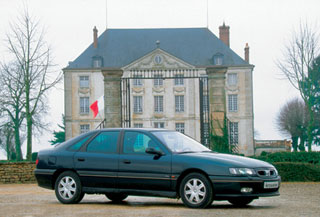Test drive by Renault Safrane 1996 - 2000 hatchback
A modest sprinter
 Its appearance is modest and almost devoid of hints of aggressiveness. The essence of the Renault Safrane Biturbo is hidden from the eyes, and only the Moramman can evaluate it.
Its appearance is modest and almost devoid of hints of aggressiveness. The essence of the Renault Safrane Biturbo is hidden from the eyes, and only the Moramman can evaluate it. At the time of our acquaintance, she was hit for five years. The age for the car is by no means critical, while the owner has something to tell about, some experience has been accumulated.
Despite the aggressiveness of character, you can’t call a sports car - this is a large comfortable four -door sedan. There is a lot of interesting things in the cabin, for example, leather electro -regulatory seats (driver's - with three memory compartments), with electric heating and six cavities for pumping. One of them is located under the knees, two - along the back on the left and right, and three more - across. Several buttons with icons allow you to simulate the most convenient profile. The steering column is adjustable along the angle of inclination and length.
The device set is the most common, however, there is also a computer display showing instant, medium and general fuel consumption, as well as mileage before inspection. The cool option is associated with the brains: Franco -speaking mob. Around the lever of a 5-speed gearbox, there are buttons responsible for the choice of shock absorbers, the body level and the location of the center viscose coupling. A little higher - Philips CD reserve (4x20 W) with a graphic equalizer. A lot of wooden inserts, frontal pillows - two.
There are very few outdoor differences from more calm versions - the nostrils of the larger cladding, the massive grille of the air intake in the front spoiler (two interculers are hidden behind it) and 17 -inch wheels. Almost standard four -door sedan. The price and repair of the machine implies that the owner is far from poor, preferring to see himself as a driver and is not a kettle: not everyone can tame 268 horses.
The French designers of cars have always been distinguished by identity. It is impossible to call Renault Safrane Biturbo a revolutionary, rather, it is not entirely common - due to many non -traditional solutions used in it.
The engine of the car is probably familiar to many. Exactly the same is on Citroen XM (motor #1-2, 2000). This is a long -standing development of Renault with V6 configuration and only two valves - on a cylinder. At first glance, it is strange, because there is a more powerful twin brother V6.24. On the other hand, he is famous for its low reliability.
In a calm, atmospheric, the execution of the power unit, he had a capacity of exactly 100 horses less than in the Biturbo version. The degree of compression of our motor is reduced by two units (up to 7.6: 1), taking into account excess air, pumped under a pressure of 0.5 bar. A pair of superchargers (one on the head) is spent faster than the only one due to the smaller mass of the rotors - this improves the dynamic characteristics of the machine. The action of turbines becomes noticeable at 3200-3500 vol./Min. Changed characteristics demanded to use a new graduation tract. Suspicion of the tuning origin of the exhaust system was neither confirmed or refuted due to the lack of a manufacturer’s marking on it.
 In the biography of this instance of Safrane, a German trace is traced. The car lived for some time in Germany and, apparently, was subjected to surgical intervention there. In any case, the front brake mechanics is from BMW, which is uncharacteristic.
In the biography of this instance of Safrane, a German trace is traced. The car lived for some time in Germany and, apparently, was subjected to surgical intervention there. In any case, the front brake mechanics is from BMW, which is uncharacteristic. The car suspension can change its rigidity, as well as the position of the body relative to the road. In this she is helped by controlled shock absorbers and pumped pillows-priests. He controls this, made with an eye on Citroen, an economy computer. The driver himself can choose the mode. On the way, electronics respond to acceleration, slowdown, longitudinal and transverse tanking of the body, rotation of the steering wheel and distribution of the load. If, for example, load the trunk with a bag of sugar, then the feed will first go through, and then again will rise to the original level.
Recently, the all -wheel drive transmission has become widespread in ordinary, not off -road vehicles. They get to our tests quite often, but, frankly, all sorts of smart devices that redistribute torque, depending on the situation, have fed up with the order. I do not want to say anything bad, but unceremonious interference in the process of driving, often causing it unpredictable behavior, sometimes makes you strain. The Safrane Biturbo has an intended viscose clutch for everyone is good - until the driver will hit the fool in the head. The exorbitant power of the motor, distributed by four contact spots, constantly provokes to stagnate the gas pedal to the floor. If extreme driving for the driver is not an empty phrase, I recommend that you previously block the coupling (the joy of constant hard all -wheel drive is now in a shortage): only then you can fully enjoy the fantastic controllability of Safrane.
Everyone, who occasionally buying car periodicals, can say smart regarding the controllability of the anterior, posterior or four-wheel drive cars. But I suspect that not every theorist has the possibility of comparing different types of drives live. Being a passionate fan of the classic drive, I can not but get enough of a full -wheel drive Frenchman who behaves almost like a rear -wheel drive.
The case took place in early March. Cold. The frosty night turned the melted snow into a semblance of a rink. Non -navigated rubber promised a bouquet of impressions. At first I just ride a straight line. Back and forth. Shock absorbers are in a rigid, sports mode. Shocks, but moderately. Where the mono -proceed is helplessly slipping, Renault Safrane accelerates, as in dry asphalt. Everything is logical, because the torque is transmitted not to two, but to four tires. About dry asphalt - not a word of red for the sake, exchange rate stability is striking. The stains of asphalt and irregularities are trying to knock down the car with a straight line, to expand, but it, shrugging, itself returns to the previous trajectory.
To someone like, but I am interested in the highest aerobatics, the creation of critical situations and the way out of them. The most unpleasant on the road is the skid. It can occur for various reasons. Passenger safety depends on the ability to control the car at this moment and return it to the desired course. I’m trying to break into the side sliding - the car opposes this in every possible way, only after preliminary buildup it is possible to stand across the road. The speed is about 150 km/h, the car glides like skiing - it seems that the control is lost completely ... I turn the steering wheel towards the drift, and - Oh, miracle! - After a few moments, I return to the starting position. Sharp discharge or overkill of gas is harmful - you can tear the car into uncontrolled rotation. An accurate dosage can be made by Safrane even move sideways.
The logic and predictability of behavior allow you to easily move around the circumference and pass turns in lateral sliding. This is not a simple diet. Winter ralists will understand me ... you go along a rolled winter forest road, along the roadsides - sparkling snowdrifts, black shaggy spruce, speed grows, a snow whirlwind, a speedometer to the limit, and ahead of the turns, and oh, how I do not want to crush On the brake! Yes, and why, because I'm going to Renault Safrane Biturbo! However, do not console yourself with thoughts about the ease of communication with the Frenchwoman. It can be a obstinate. To feel its character, it does not interfere with choosing a suitable platform and from the heart to practice from it. At the same time, it is desirable to have at least elementary extreme driving skills on the rear -wheel drive. Some differences, of course, occur, but are easily captured and adjusted in place ...
Low -profile rubber (the owner put a slightly wider - 235/45R17) pierces on our roads, while the tires suffer more than cast discs. For several years of operation, no serious breakdowns did not happen, but the weak spot was still revealed-the mechanics of the air suspension. It is not at all designed for that aggressive chemistry with which we destroy snow, ice and cars. As a result, pneumatic trowepers are torn. One owner instead of them was put on racks from the usual Safrane. But what result can a sprinter be hoped in orthopedic boots?
Alexey Strelkov
Source: Motor magazine [No. 5/2000]




